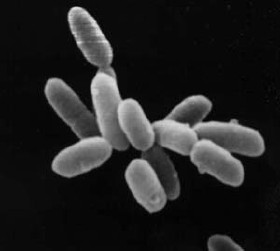Related Research Articles
A halophile is an extremophile that thrives in high salt concentrations. In chemical terms, halophile refers to a Lewis acidic species that has some ability to extract halides from other chemical species.

Halobacterium is a genus in the family Halobacteriaceae.
Halobacteriaceae is a family in the order Halobacteriales and the domain Archaea. Halobacteriaceae represent a large part of halophilic Archaea, along with members in two other methanogenic families, Methanosarcinaceae and Methanocalculaceae. The family consists of many diverse genera that can survive extreme environmental niches. Most commonly, Halobacteriaceae are found in hypersaline lakes and can even tolerate sites polluted by heavy metals. They include neutrophiles, acidophiles, alkaliphiles, and there have even been psychrotolerant species discovered. Some members have been known to live aerobically, as well as anaerobically, and they come in many different morphologies. These diverse morphologies include rods in genus Halobacterium, cocci in Halococcus, flattened discs or cups in Haloferax, and other shapes ranging from flattened triangles in Haloarcula to squares in Haloquadratum, and Natronorubrum. Most species of Halobacteriaceae are best known for their high salt tolerance and red-pink pigmented members, but there are also non-pigmented species and those that require moderate salt conditions. Some species of Halobacteriaceae have been shown to exhibit phosphorus solubilizing activities that contribute to phosphorus cycling in hypersaline environments. Techniques such as 16S rRNA analysis and DNA–DNA hybridization have been major contributors to taxonomic classification in Halobacteriaceae, partly due to the difficulty in culturing halophilic Archaea.

Halobacteriales are an order of the Halobacteria, found in water saturated or nearly saturated with salt. They are also called halophiles, though this name is also used for other organisms which live in somewhat less concentrated salt water. They are common in most environments where large amounts of salt, moisture, and organic material are available. Large blooms appear reddish, from the pigment bacteriorhodopsin. This pigment is used to absorb light, which provides energy to create ATP. Halobacteria also possess a second pigment, halorhodopsin, which pumps in chloride ions in response to photons, creating a voltage gradient and assisting in the production of energy from light. The process is unrelated to other forms of photosynthesis involving electron transport; however, and halobacteria are incapable of fixing carbon from carbon dioxide.

Haloarchaea are a class of prokaryotic organisms under the archaeal phylum Euryarchaeota, found in water saturated or nearly saturated with salt. Halobacteria are now recognized as archaea rather than bacteria and are one of the largest groups. The name 'halobacteria' was assigned to this group of organisms before the existence of the domain Archaea was realized, and while valid according to taxonomic rules, should be updated. Halophilic archaea are generally referred to as haloarchaea to distinguish them from halophilic bacteria.

Haloarcula is a genus of extreme halophilic Archaea in the class of Halobactaria.
Halobiforma is a genus of halophilic archaea of the family Natrialbaceae.
Halococcus is a genus of the Halococcaceae.

Haloquadratum is a genus of archaean, belonging to the family Haloferacaceae. The first species to be identified in this group, Haloquadratum walsbyi, is unusual in that its cells are shaped like square, flat boxes.
Halorubrum is a genus in the family Halorubraceae. Halorubrum species are usually halophilic and can be found in waters with high salt concentration such as the Dead Sea or Lake Zabuye.
In taxonomy, Halosimplex is a genus of the Halobacteriaceae.
Haloterrigena is a genus of the Natrialbaceae.
In taxonomy, Natrialba is a genus of the Natrialbaceae. The genus consists of many diverse species that can survive extreme environmental niches, especially they are capable to live in the waters saturated or nearly saturated with salt (halophiles). They have certain adaptations to live within their salty environments. For example, their cellular machinery is adapted to high salt concentrations by having charged amino acids on their surfaces, allowing the cell to keep its water molecules around these components. The osmotic pressure and these amino acids help to control the amount of salt within the cell.
Natrinema is a genus of the Natrialbaceae.
In taxonomy, Natronococcus is a genus of the Natrialbaceae.

Haloferax volcanii is a species of organism in the genus Haloferax in the Archaea.
Halobacterium noricense is a halophilic, rod-shaped microorganism that thrives in environments with salt levels near saturation. Despite the implication of the name, Halobacterium is actually a genus of archaea, not bacteria. H. noricense can be isolated from environments with high salinity such as the Dead Sea and the Great Salt Lake in Utah. Members of the Halobacterium genus are excellent model organisms for DNA replication and transcription due to the stability of their proteins and polymerases when exposed to high temperatures. To be classified in the genus Halobacterium, a microorganism must exhibit a membrane composition consisting of ether-linked phosphoglycerides and glycolipids.

Shiladitya DasSarma is a molecular biologist well-known for contributions to the biology of halophilic and extremophilic microorganisms. He is a Professor in the University of Maryland Baltimore. He earned a PhD degree in biochemistry from the Massachusetts Institute of Technology and a BS degree in chemistry from Indiana University Bloomington. Prior to taking a faculty position, he conducted research at the Massachusetts General Hospital, Harvard Medical School, and Pasteur Institute, Paris.

Halorubrum lacusprofundi is a rod-shaped, halophilic Archaeon in the family of Halorubraceae. It was first isolated from Deep Lake in Antarctica in the 1980s.
Halococcaceae is a family of halophilic and mostly chemoorganotrophic archaea within the order Halobacteriales. The type genus of this family is Halococcus. Its biochemical characteristics are the same as the order Halobacteriales.
References
- 1 2 3 4 5 6 7 8 9 10 Ventosa, Antonio; Gutiérrez, M. Carmen; Kamekura, Masahiro; Dyall-Smith, Michael L. (1999-01-01). "Proposal to transfer Halococcus turkmenicus, Halobacterium trapanicum JCM 9743 and strain GSL-11 to Haloterrigena turkmenica gen. nov., comb. nov". International Journal of Systematic and Evolutionary Microbiology. 49 (1): 131–136. doi: 10.1099/00207713-49-1-131 . PMID 10028254.
- 1 2 3 4 5 Zvyagintseva, IS; Tarasov, AL (1987). "Extreme halophilic bacteria saline soils". Mikrobiologiia. 56: 839–844.
- 1 2 3 4 5 6 7 8 9 10 11 12 13 14 15 16 17 18 19 20 Selim, Samy; Hagagy, Nashwa (2016-03-01). "Genome sequence of carboxylesterase, carboxylase and xylose isomerase producing alkaliphilic haloarchaeon Haloterrigena turkmenica WANU15". Genomics Data. 7: 70–72. doi:10.1016/j.gdata.2015.11.031. PMC 4778622 . PMID 26981365.
- ↑ Saunders, Elisabeth; Tindall, Brian J.; Fähnrich, Regine; Lapidus, Alla; Copeland, Alex; Rio, Tijana Glavina Del; Lucas, Susan; Chen, Feng; Tice, Hope (2010-02-28). "Complete genome sequence of Haloterrigena turkmenica type strain (4k T )". Standards in Genomic Sciences. 2 (1): 107–16. doi:10.4056/sigs.681272. ISSN 1944-3277. PMC 3035258 . PMID 21304683.
- 1 2 Robinson, Jessie L.; Pyzyna, Brandy; Atrasz, Rachelle G.; Henderson, Christine A.; Morrill, Kira L.; Burd, Anna Mae; DeSoucy, Erik; Fogleman, Rex E.; Naylor, John B. (2005-02-01). "Growth Kinetics of Extremely Halophilic Archaea (Family Halobacteriaceae) as Revealed by Arrhenius Plots". Journal of Bacteriology. 187 (3): 923–929. doi:10.1128/JB.187.3.923-929.2005. ISSN 0021-9193. PMC 545725 . PMID 15659670.
- ↑ Woese, C R; Kandler, O; Wheelis, M L (1990-06-01). "Towards a natural system of organisms: proposal for the domains Archaea, Bacteria, and Eucarya". Proceedings of the National Academy of Sciences of the United States of America. 87 (12): 4576–4579. doi: 10.1073/pnas.87.12.4576 . ISSN 0027-8424. PMC 54159 . PMID 2112744.
- ↑ Aziz, Ramy K.; Bartels, Daniela; Best, Aaron A.; DeJongh, Matthew; Disz, Terrence; Edwards, Robert A.; Formsma, Kevin; Gerdes, Svetlana; Glass, Elizabeth M. (2008-01-01). "The RAST Server: Rapid Annotations using Subsystems Technology". BMC Genomics. 9: 75. doi: 10.1186/1471-2164-9-75 . ISSN 1471-2164. PMC 2265698 . PMID 18261238.
- 1 2 Gribaldo, Simonetta; Brochier-Armanet, Celine (2006-06-29). "The origin and evolution of Archaea: a state of the art". Philosophical Transactions of the Royal Society of London B: Biological Sciences. 361 (1470): 1007–1022. doi:10.1098/rstb.2006.1841. ISSN 0962-8436. PMC 1578729 . PMID 16754611.